U.S. Coast Guard Auxiliary - Public Affairs - History Program

First and Second World War Monuments
Memorializing the U.S. Coast Guard
Most Americans are unaware that the U.S. Coast Guard fought valiantly alongside sailors, marines, and soldiers in both world wars. Despite the public’s limited understanding of this sea service’s extensive wartime history, there are several monuments and memorials that recognize the sacrificial service of the active duty, reserve, and Auxiliary members of the U.S. Coast Guard. This essay sheds light on a few of the memorials honoring the U.S. Coast Guard’s service and sacrifice in wartime.
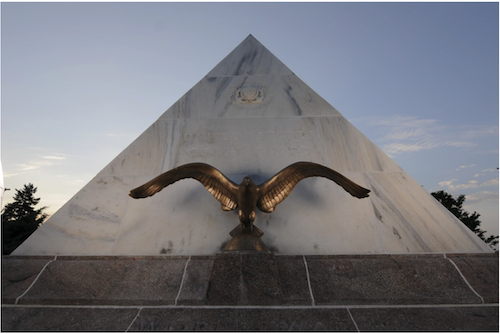
Coast Guard World War Memorial, Arlington National Cemetery, VA. United States
Image provided by DVIDS, Senior Chief Petty Officer Michael Hvozda
When the United States finally decided to enter the World War, (or “Great War,” as it was called in most of the English-speaking countries) in April of 1917, the Coast Guard was put to work protecting Allied ship convoys as they travelled through seas infested with German submarines. Formed into Squadron 2 of Division 6 of the U.S. Navy’s Atlantic Fleet in the late summer of 1917, the cutters Seneca, Manning, Yamacraw, Algonquin, Ossipee, and Tampa provided escort protection for Allied convoys between the British Isles and Gibraltar in what proved to be the final year of the war. The lost eleven men on September 17, 1918, after crewmen volunteered to salvage the British steamer Wellington that was singking in the Bay of Biscay. Ten days later, on September 26, the cutter USS Tampa, after returning to Great Britain from convoy escort duty, was destroyed after presumably being attacked by a German submarine as she sailed for port. All hands died: of the 115 aboard ship that evening, 111 were Coast Guardsmen
These two events were the impetus for the erection of the U.S. Coast Guard Memorial in Arlington National Cemetery, dedicated on May 23, 1928. The foundation of the monument is a large, rock-encrusted navigational compass; on top of the base sits a twelve-foot-tall white marble pyramid inscribed with the names of Coast Guard personnel who died during the First World War. On the frontside of the monument is the Coast Guard shield and motto, Semper Paratus. In front of the monument near the base is a sculpted, bronze seagull with outstretched wings above the words “World War.” (Before World War II, the 1914-1918 conflict was known without its numeric designation.) The monument was designed by architect George Howe and sculptor Gaston Lachaise, who intended to evoke strength, steadfastness, and the idea that the Coast Guard was constantly watching over the nation as it patroled the United States’ coastal waters. The memorial blends nature, maritime tradition, ancient Egyptian history and the venerated names of the Coast Guard’s dead. One side of the pyramid recognizes the dead crewmen from the Seneca, whose names appear under the homage that they were “lost in bravely endeavoring as volunteers to salvage torpedoed British steamer Wellington Bay of Biscay September 17, 1918.” Below the names of the Seneca dead, under the title, “These Too Died for Country” are inscribed the names of 75 Coast Guard officers and enlisted men who lost their lives during the war. On another side of the pyramid are the names of the crew of the Tampa, under the tribute, “Officers and men U. S. Coast Guard Cutter Tampa sunk by enemy submarine in Bristol Channel September 26, 1918 when all on board were lost.” Sadly, the Arlington monument would not be the last memorial to the Coast Guard’s war dead. Little more than thirteen years after the Coast Guard’s “World War” memorial was dedicated, the United States would be swept into another world conflict, one much longer and costlier in lives than the first.
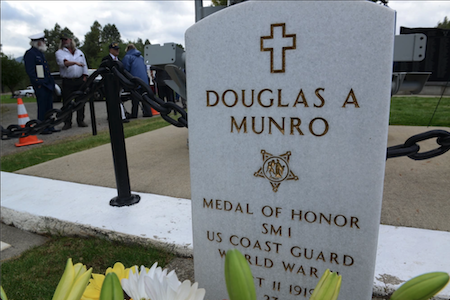
Second World World - 77th Anniversary of Battle of Guadalcanal, Cle Elum, WA, United States
Image provided by DVIDS, Chief Petty Officer William Colclough USCG District 13
Douglas Albert Munro
For the U.S. Coast Guard, twenty-two-year-old Signalman First Class Douglas Albert Munro’s actions have come to epitomize the values and virtues associated with unselfish sacrifice to save others. Munro’s commanding officer, Lieutenant Commander Dwight H. Dexter, in a letter to Munro’s parents explaining the circumstance of their son’s death, wrote, “I have pride in telling you that he covered himself with honor and I hope Glory, and fulfilled the mission so satisfactorily that almost all of the men he had under his charge returned to their unit and without exception all had praise for your son’s execution of his duties.” On Sunday, September 27, 1942, Munro volunteered to lead a rescue mission for a battalion of U. S. Marines trapped at Guadalcanal. As the last of the marines were being evacuated from the beach, Munro realized that his remaining landing craft were exposed to Japanese fire. He positioned his vessel so it could “shield” the other boats and the remaining marines as they scrambled off the beach. Near the end of the gunfight with the Japanese, Munro was mortally wounded as the last of the boats withdrew. His actions were so extraordinary that Munro was posthumously awarded the Medal of Honor, the first and only time this decoration was bestowed on a member of the USCG.
The first phase of Munro’s memorialization happened soon after his death, when a new Navy destroyer escort was christened the USS Douglas A. Munro (DE 422) in March 1944. Memorials honoring Munro’s bravery eventually appeared at his burial site in Cle Elum, Washington; in the Solomon Islands, where his heroic actions occurred; at the Coast Guard Academy; and the Coast Guard Training Center in Cape May, New Jersey. In addition to the monuments, two Coast Guard cutters were named in his honor, WHEC 724, a Hamilton-class high endurance cutter commissioned in 1971; and WMSL 755, a national security cutter commissioned in 2017. A marching song was composed in Munro’s honor; an inspirational leadership is awarded by the Navy League in his memory; and he has several other tributes that recall his heroic actions at Guadalcanal. These forms of commemoration are noteworthy, because no single individual holds a similar place of veneration in any of the other military services. Munro’s memory, in fact, moves beyond the boundaries of a single man’s actions in combat to epitomize the lifesaving ethos of the Coast Guard and the preeminent notion of devotion to duty.
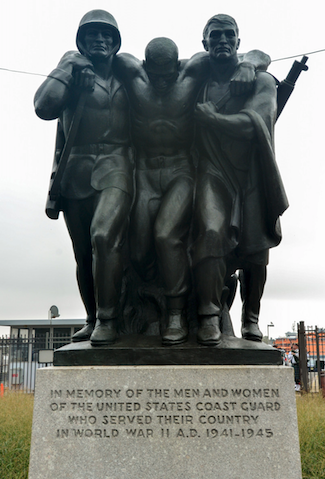
Coast Guard Memorial in New York City
Image by New York Parks, Sculptor Norman M. Thomas 1947
New York City’s Battery Park
On May 30, 1955, in New York City’s Battery Park in lower Manhattan, the Coast Guard dedicated a memorial to the “172,000 men and women who served in the Coast Guard during World War II.” The monument depicts three individuals, two of them Coast Guardsmen with rifles slung over their shoulders, helping to carry a wounded U. S. Army soldier to safety. The bronze figures are nine feet high and mounted on a granite base inscribed with the words, “In Memory of the Men and Women of the United States Coast Guard who Served their Country in World War II A.D. 1941-1945.” The monument was based on a sketch by Coast Guard combat artist Norman Millet Thomas, who had witnessed the poignant event during the Luzon landing in the fight to retake the Philippines from the Japanese.
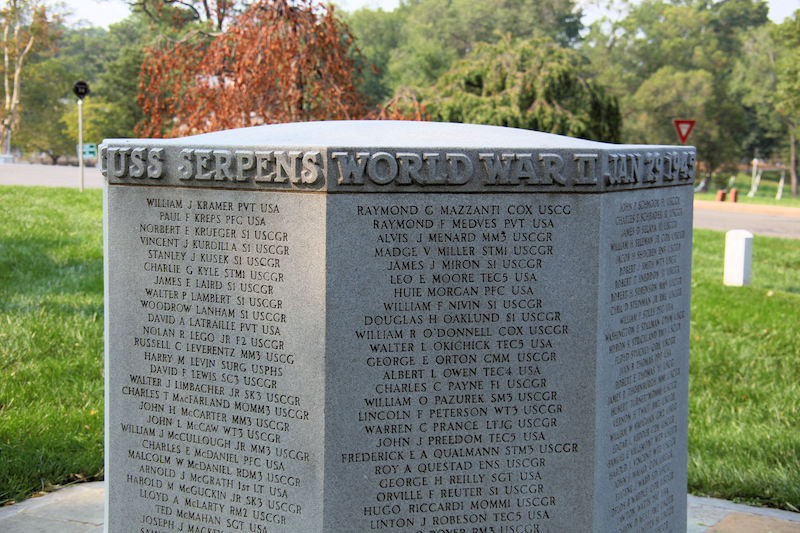
Memorial to the dead of USS Serpens at Arlington National Cemetery
Image by Wikipedia
USS Serpens
The USS Serpens, a Coast Guard-manned cargo ship, blew up off Guadalcanal during the process of off-loading ammunition on January 29, 1945. Its sinking was the single, greatest loss of Coast Guard personnel during the Second World War. All told, 193 Coast Guardsmen men died that day, along with 56 U.S. Army soldiers and the U.S. Public Health Service physician assigned as the ship’s doctor. The Serpens crew was buried in temporary American cemeteries in the theater of war, but their bodies were exhumed later and reinterred in a mass grave on June 15, 1949, in Arlington National Cemetery. The reburial of the Serpens dead was accomplished in a formal, public reinterment ceremony that included dignitaries, surviving family members, and solemn music performed by the U. S. Marine Band. An octagonal, stone monument was installed near the graves and inscribed with the names of all who died.
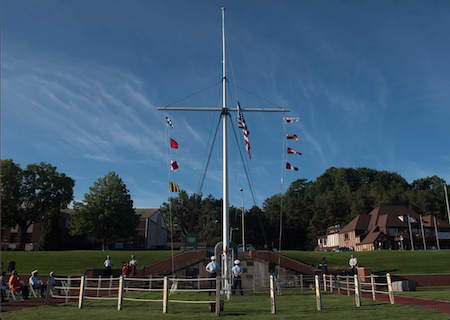
Coast Guard members honored at 2020 National Memrial Service in Grand Haven
Image by DVIDS, Grand Haven, MI, United States - Chief Petty Officer John Masson USCG District 9
USCG Cutter Escanaba
The U. S. Coast Guard cutter Escanaba was stationed at Grand Haven, Michigan, from 1933 until just before the United States formally entered World War II. In 1941 the cutter was reassigned to the Greenland Patrol in the North Atlantic. Tragically, in June of 1943, while on convoy-escort duty, the Escanaba fell victim to a German U-Boat attack—101 of the 103 crew aboard the Escanaba perished within minutes. In 1944, the Escanaba’s mast, which earlier had been removed when the ship was refitted for wartime service, was erected in Grand Haven’s Kelly Park, along the Lake Michigan waterfront, to commemorate the vessel and her crew. To further recognize Escanaba’s loss, a permanent, “living memorial” park was established in 1949 that included other items from Escanaba, along with a plaque renaming the site “Escanaba Memorial Park.” In 1998, the Commandant of the Coast Guard, under an Act of Congress, designated Grand Haven the first “Coast Guard City, USA.” To this day, an annual celebration draws tens of thousands of visitors over the multi-day event that educates the public about the U.S. Coast Guard, as well as remembering those who have paid the ultimate price as “America’s Maritime Guardians.”
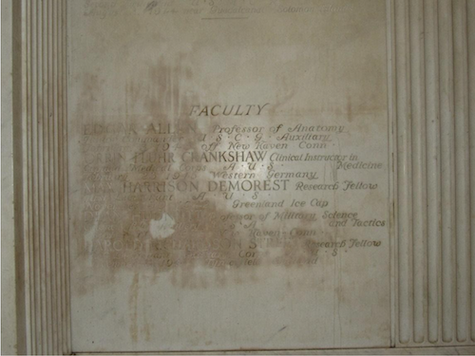
Yale University's Memorial Hall
Image by Darin D. Lenz, Ph.D.
Yale University’s Memorial Hall
At the corner of Grove and College streets in New Haven, Connecticut, is a large rotunda at the entrance to Memorial Hall where the names of Yale’s faculty and students who died in America’s wars are inscribed on the marble walls. Originally designed as a Civil War memorial that intended to bring reconciliation among Yale students and alumni from the North and the South, the memorial evolved over the decades into a collective remembrance of war dead. In a far corner of Memorial Hall is a slab of marble engraved with the word “Faculty.” Under this heading appear the names of five Yale faculty members who died in the service of the United States during the Second World War. The first is that of Edgar Allen, who was Professor of Anatomy and Chairman of the Department of Anatomy at Yale University School of Medicine.
A U. S. Army veteran of the First World War and an avid sailor since his youth, Allen decided to join the U.S. Coast Guard Auxiliary after the attack on Pearl Harbor. While commanding an Auxiliary patrol in Long Island Sound off the coast of New Haven, Allen died of a heart attack on February 3, 1943, at the age of 50. Even though he was not officially serving as anything more than a civilian volunteer in the Coast Guard Auxiliary, Yale University chose to commemorate their esteemed colleague with a place of honor among the war dead of Memorial Hall.
by Darlin D. Lenz, Ph.D.
Branch Assistant, Pacific-Area Historian's Office Liaison
Other Memorials Honoring the U.S. Coast Guard
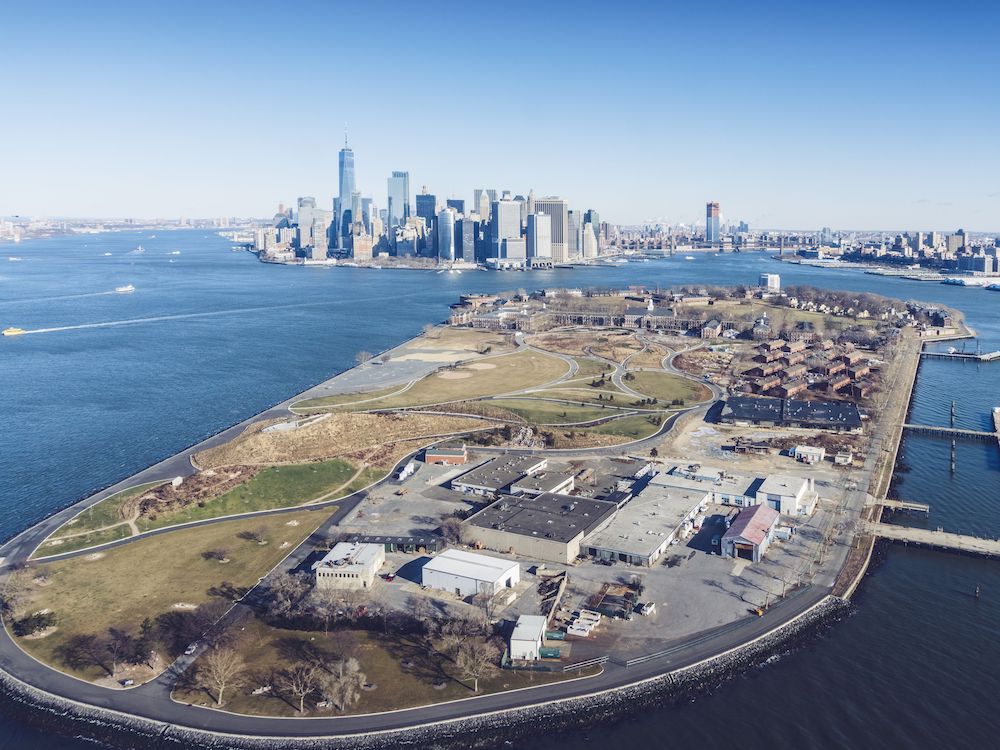
Governors Island
When the Coast Guard moved its major New York City base from Governors Island in New York Harbor in 1996, commanders wanted to make sure that the public would be aware that the Coast Guard had had a strong presence in the City, especially since it first located to the former army base in 1967. Historically, the Coast Guard also has a strong tradition of service in the New York region. The concept of building four small compass point monuments on the island was developed. The Coast Guard Public Affairs detachment asked Auxiliarist C. Kay Larson, then the Branch Chief for Research and Publication of the History Division, National Department of Public Affairs and a published author, to draft the text for the monuments. Coast Guard staff completed the final editing. In summary, the north monument details the establishment of the service in lower Manhattan; the west monument treats the beginning of the lifesaving and lighthouse services that had early beginnings in New Jersey; the east monument is dedicated to World War II; and the south monument mentions an array of missions on which New York cutters and personnel have been deployed. The east and south monuments note the work of the World War II Coast Guard Reserve in which thousands of Auxiliarists served and the Auxiliary, respectively. Below is the text of these two tablets:
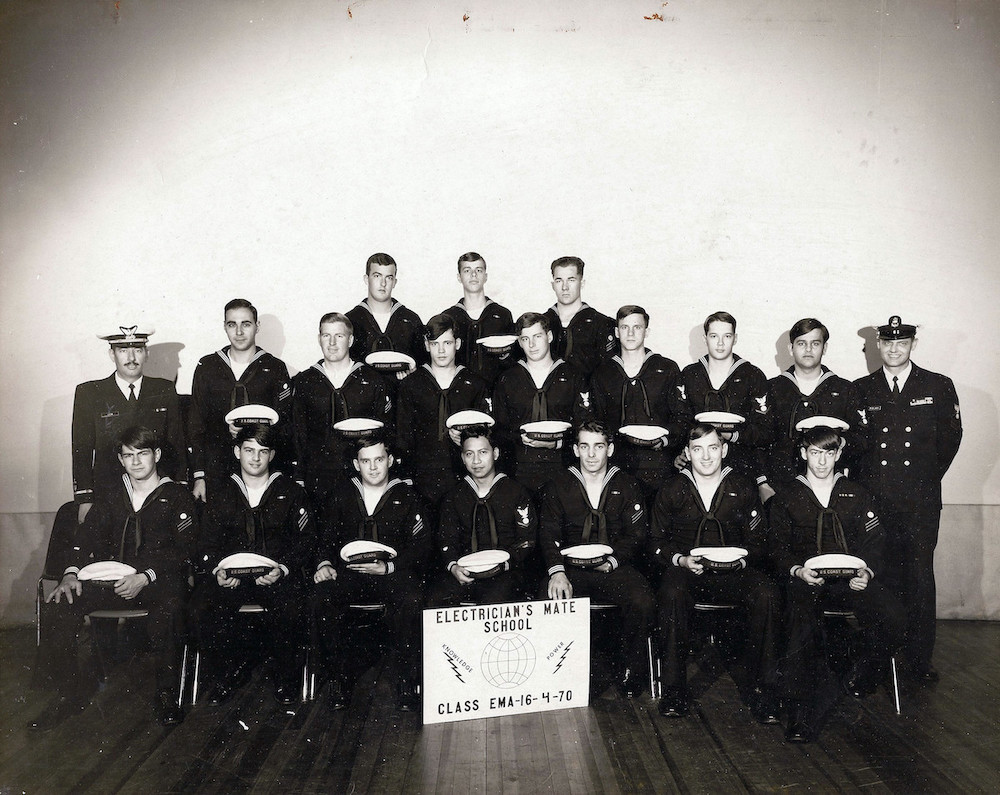
1970, USCG Training Center Governors Island, Electricians Mate School, Class EMA 16-4-70. Photo by The Military Yearbook Project.
Monument East
During World Wars I and II, New York City and the Port of New York comprised the nation's largest center of Coast Guard operations. Port security specialists guarded the arrival and departure of millions of troops and thousands of tons of war material, troop supplies and munitions. Merchant convoys were escorted across the Atlantic and along the eastern seaboard by Coast Guard cutters home ported in New York Harbor such as the Tampa, Seneca, and Campbell. The "Mosquito Fleet" of small Coast Guard and Coast Guard Reserve vessels, many of them converted private yachts, conducted anti-submarine patrols in the seaward approaches to the harbor. During World War II, the Manhattan Beach training center, located in Brooklyn, was the largest Coast Guard basic training camp in the nation. The Brooklyn-built 83-foot "matchbox fleet" of Rescue Flotilla No. 1 provided search and rescue operations during the invasion of Normandy, saving hundreds of allied soldiers from the deadly inshore waters.Monument South
Throughout the nation's history, the people and vessels of the U.S. Coast Guard and its forebears have departed from New York to fight for our nation's freedom and protect her economic interests. During the War of 1812, the Revenue Cutter Vigilant captured the British privateer Dart in nearby waters, where hand-to-hand combat during the boarding made it one of the most daring captures of the War. New York vessels waged Prohibition's "Rum War" in the 1920s. Drug interdiction was prosecuted locally and in the Caribbean from the 1970s on. For years, Governors Island based cutters conducted Caribbean operations, rescuing tens of thousands of Cuban refugees in 1980 and Cuban and Haitian refugees in 1994.Brave men and women of the Coast Guard, the Coast Guard Reserve and Coast Guard Auxiliary have battled the hostile forces of nature, in aircraft and vessels, to save lives and assist distressed vessels. The U.S. Life Saving Service, founded in New Jersey in 1848, had a saying: "You have to go, but you don't have to come back." All America honors those Coast Guard personnel who went out, and particularly those who did not come back.
5th Coast Guard District, Northern Region
During the 2002 spring graduating class ceremonies, Rear Adm. Sally Brice-O’Hara presided over the dedication of a memorial honoring members of the Coast Guard Auxiliary at the Coast Guard’s enlisted training center in Cape May, New Jersey. The granite monument is located on [Douglas A.] Munro Avenue, surrounded by a small garden. The words inscribed are: “The Coast Guard Auxiliary is the civilian volunteer arm of the of the United States Coast Guard. Brave men and women who donate their time and expertise to support the Coast Guard and improve boating safety.” Signalman first class Munro was the only Coastguardsman to have been awarded the Medal of Honor during World War II. He was killed while providing covering fire during the evacuation of Marines off Guadalcanal in 1942.5th Coast Guard District, Southern Region
On August 04, 2000, a memorial to all Coast Guard air crews who have lost their lives while conducting ordered missions was dedicated at Coast Guard Air Station, Elizabeth City, North Carolina. Names of those killed include Coast Guard Auxiliary members. The Coast Guard Auxiliary air program was initiated at the end of World War II and has been an important part of Auxiliary operations since then. Pilots and crews fly search and rescue missions; ferry personnel and equipment; conduct flood, levee, and ice patrols; and search for floating navigation hazards, missing vessels, and sometimes fleeing felons. They also train with active duty Coast Guard air units.The following Auxiliarists are listed on the air memorial as of November 2002:
- 8 July 1984 PA-23-160 N4167P
Mr. H. J Mau III, USCG Aux
Mrs. M. L. Mau, USCG Aux
- 21 January 1989 PA-28-180
Mr. R. C. Smilgoff, USCG Aux
Mrs. L. Smilgoff, USCG Aux
- 18 September 1989 BE-A35 N566B
Mr. R. J. Duffield, USCG Aux
Mr. G. B. Rene, USCG Aux
- 12 May 1990 BL-17-31A N7SF
Mr. R. Anderson, USCG Aux
Mr. C. Polimeni, USCG Aux
Ms. J. Nappi, USCG Aux
Ms. C. Huhne, USCG Aux
- 13 January 1992 C172 N121L
Mr. G. Feig, USCG Aux
- 2 January 1997 AA5-B N28297
Ms. F. Lizak, USCG Aux
Mr. F. Lizak, USCG Aux
- 1 Feb 2001 PA-32 N99WD
Mr. R. S. Fuller USCG Aux
Mr. C. A. Purvis USCG Aux
9th Coast Guard District, WR
A Coast Guard Auxiliary memorial wall situated in Escanaba Park, Grand Haven, Michigan was dedicated in August 1998. It consists of a slab monument backed by a semi-circular terraced brick wall At first the inscription contained the names of members of the Auxiliary who had passed away between January 1, 1996 and December 31, 1997. Each year new names from the District are added. The project was initiated by Past Commodore Richard Ives in 1997. Auxiliary members are honored each year at the National Memorial Service held during Coast Guard Days at Grand Haven. This small city, a.k.a. Coast Guard City, became the home of this event due to the loss of a Coast Guard cutter during World War II.The 165-foot USCGC Escanaba was constructed in Michigan and home ported at Grand Haven, first assigned to icebreaking duties on the Great Lakes. Following the outbreak of the war, the cutter participated in the Greenland Patrol in the North Atlantic. While on convoy duty in the early morning of June 13, 1943, the Escanaba exploded and sank quickly. Although there were 2 survivors, 101 officers and men lost their lives. The loss was later attributed to a German torpedo. Grand Haven’s services to honor the Escanaba blossomed over the years into a yearly Coast Guard Days Festival held each summer which thousands of visitors attend.
11th Coast Guard District
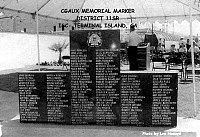
The Past Captains' Association of the 11th Coast Guard District maintains this memorial that lists the names of District Auxiliarists who have passed over the bar since 1967. Originally constructed in 1970, six onyx stones bear the names of 675 Auxiliarists of the region. The stones are set on concrete platforms with pegs so that the memorial can be moved to different locations on the base. Today the memorial is located next to the water with an Auxiliary flag flying overhead.